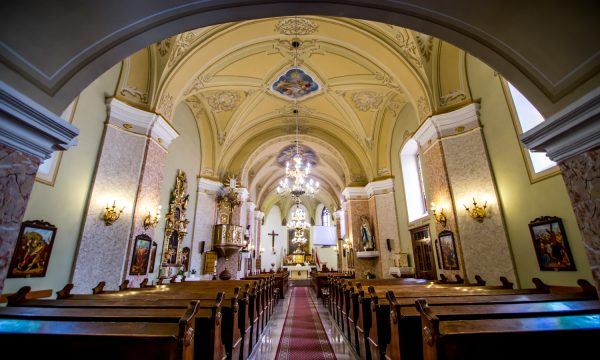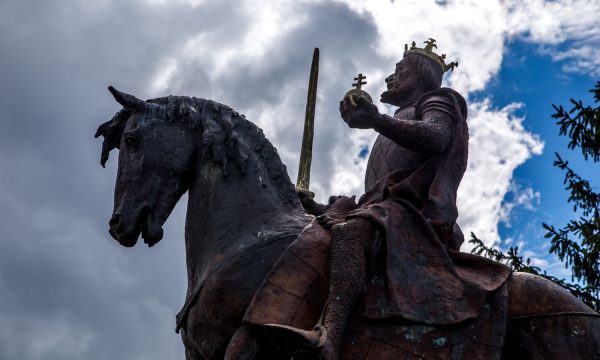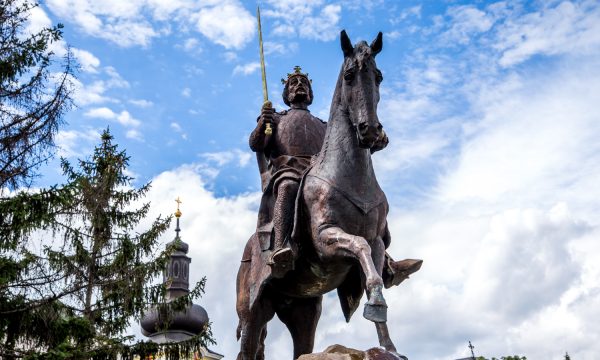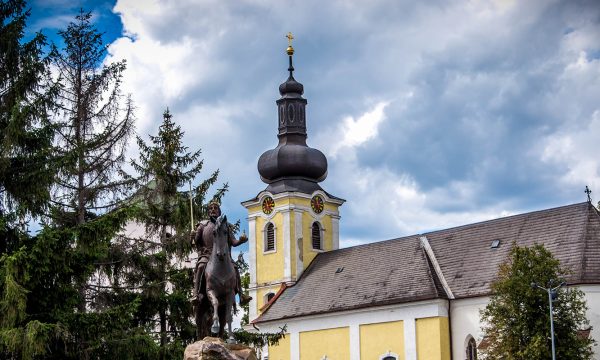Wall painting
The original Roman Catholic church in Kisvárda was ordered to be built by St. Ladislaus at the end of the 11th century, but only archaeological excavations could reveal its foundation. The destruction brought by the Mongol invasions (1241) was unavoidable in the case of this building too, and after its restoration the building was probably rebuilt in the mid-14th century, around 1330–1350.

The medieval church of the former market-town is located on the road leading from the ferry crossing between Salamon (today: Salamonovo, Ukraine) – Záhony, across Kisvárda to Kálló. Its choir and nave were covered with a single roof made of Austrian historic slates in 1975. The year 1806 can be read on the stone-framed entrance of the protruding tower, which has a 27m height without its spire, attached to the western side of the church. The four-storey tower (ground floor + 3 floors) has a pleasant structure; on the top floor with an upper arched moulding we find four semicircular louvered windows facing the cardinal points.
The long Gothic choir, which closes in three sides of an octagon, reinforced with buttresses of dressed stone is lighted by three ogival stone framed windows on the southern side and one ogival window on the south-eastern wall. The stone tracery of the windows with foil arches was made during the restoration of the monument in 1970, as earlier photographs showed windows with no tracery. The choir and the late Baroque sacristy was attached to the northern side of the nave.

The brick wall fence surrounding the church on the southern and western side was commissioned to be built by Ignác Györgyényi, the parish priest and the first historian of the town, after 1867.
A vaulted organ gallery is situated at the western end of the church. On the northern wall of the domical-vaulted nave we can see the early Baroque altar with the Krucsay coat of arms brought over from the castle. The corbels carved with heads of humans/ busts, which used to belong to the late Gothic ribbed vaulting made of stone, demolished at the beginning of the 18th century, are interesting parts of the church. The following persons are depicted: Saint Peter who can be identified from his attribute, the key, but S. Petrus can also be read on a ribbon. Towards the east, another patron saint of the church, the also balding St. Paul is depicted in its immediate vicinity: the inscription (S. Paulus) also on a ribbon confirms this next to the sword with an almost spherical pommel. The three carved figure corbels on the eastern side of the choir do not bear inscriptions, so their identification is not that easy. The third portrait after the two patron saints is a man’s head with curly hair, short beard and a crown, wearing a pleated cloak. A fat, jug-eared, smooth-faced man is looking at us from the fourth corbel, with his hair combed forward on the right side, also wearing a pleated cloak. It looks like his neck is covered with a collar. His neighbour, carved on the fifth corbel is the half-length portrait of a man with big ears sticking out, a large moustache and a beard, wearing a pleated cloak. The last corbel is directly embedded in the Baroque pillar. The inscription on the ribbon, under the representation says: Ego Allexandri sum, but this does not reveal the identity of the person depicted. The man’s elongated face is covered with a thick moustache and a full beard combed on two sides. His upper body is covered either by chain mail or a cloak with horizontal ruffles and vertical pleats. The portrait reminds especially the connoisseurs of one of the most famous of the medieval St. Ladislaus’ relics, St. Ladislaus’ Herma.
The vaulting and the side-walls of the nave are covered with late Baroque and 19th-century paintings, which were repeatedly restored, with a colourful fresco on the eastern wall of the choir showing St. Ladislaus bringing water to the ground from the rocks. The vaults of the crossing and of the choir are also covered by the same painting. However, the side walls are uniformly whitewashed.
Legend
Historical sources preserve the memory of the 1085 invasion of the Upper Tisza region by Pecheneg (Cuman) forces lead by Kutesk. King Ladislaus defeated them, and raised a temple at the field of the victorious battle. According to tradition, the church in Kisvárda is a memory of this triumphant battle. In the following centuries, local Saint Ladislaus legends probably emerged in these areas of Szabolcs and Nyírség, as the legends of the later folk hero of the region, Ferenc Rákóczi II carry the motifs and general character of the Saint Ladislaus tradition. In the middle of the 20th century, the legends of the king described as ‘lord of the Nyírség’ could only be collected in Kisvárda and its surroundings. The most famous of these traditions is connected to a spring found in Savajóska area, on the border of Kisvárda, which could be said to be a folklorized legend of the 11th century triumph.

The folklore text collected by Margit Luby is as follows: ‘There is a mound in Savajóska, and it is still known in Kisvárda as the mountain of St. Ladislaus. There is a small spring in the Savajóska, still a grassy place. In the sandy area the grassy place is striking. Here, Saint Ladislaus defeated the Tartars, and set up the church in Kisvárda to commemorate this victory. Its name is still St. Ladislaus’ Church. After the battle, the army was thirsty on the sand. Saint Ladislaus prayed to God, and where the feet of his horse passed, water sprung out.’
Natural Heritage
The environment surrounding this town on the border of the Rétköz region has gone through significant changes in the past century. Although remnants of its previous flora and fauna can still be observed, its biodiversity is only a fraction of what it once was. In the past, the environment was characterized by a network of marshes, bogs, and old riverbeds supplied by the frequent floodings of the river Tisza. On the higher terrains, watery meadows and fresh pastures provided ideal conditions for animal husbandry. Today, only species like poor rushy sedges, reeds and sods, edged by groups of trees remain, although in some places small peat bogs, sudds, and willows still preserve the old face of the land.

The water violet (Hottonia palustris) is a protected plant that grows in the constantly waterlogged areas. This plant floats in the water and only its white, slightly reddish flowers emerge from it. The marsh marigold (Caltha palustris) blooms in March in the damper places. We can also find the creeping Urtica kioviensis in these areas, sometimes en masse. A native species of the marshy meadows and reeds is the Cirsium brachycephalumm, which blooms in the summer and may grow one meter tall.
The native tench or doctor fish (Tinca tinca) lives in the permanent channels and watercourses. The protected European bitterling (Rhodeus amarus) and the molluscivore spined loach (Cobitis taenia) are also found here. Due to intensive drainage and water management, the European weather loach (Misgurnus fossilis) has almost entirely disappeared from the local watercourses.
The reeds and bulrushes surrounding the town provide excellent habitats for waterbirds. The white feathered great egret (Ardea alba), the purple heron (Ardea purpurea), and the Eurasian spoonbill (Platalea leucorodia), named after its flat beak, are all highly protected and can be found in these environments, while the grey heron (Ardea cinerea) and the black-crowned night heron (Nycticorax nycticorax) are much more numerous.
The ferruginous duck (Aythya nyroca) can be easily distinguished from its cousin, the common pochard (Aythya ferina) by its maroon coloured plumage, white bottom tail coverts, bright eyes, and by the white line on its wing. It builds its nest mainly from aquatic plants in the permanent waters of lakes, marshes and backwaters of the area.
